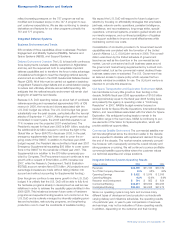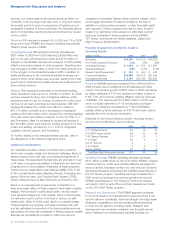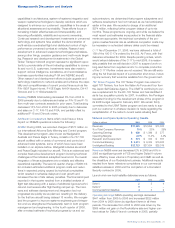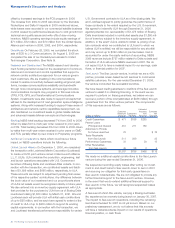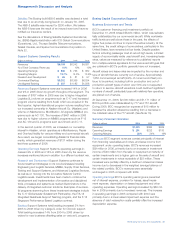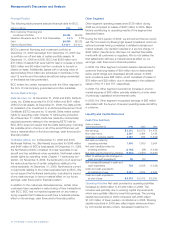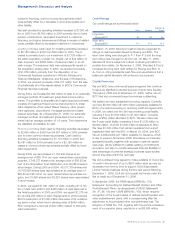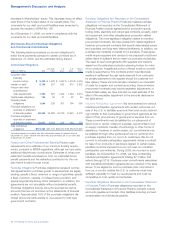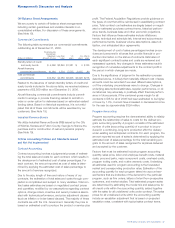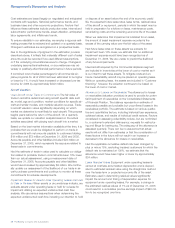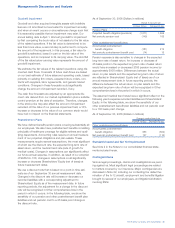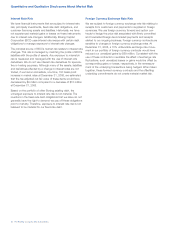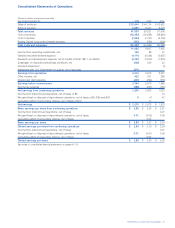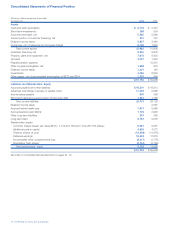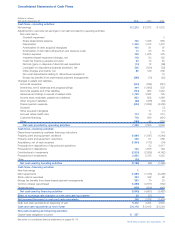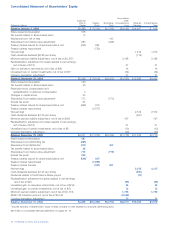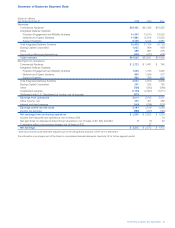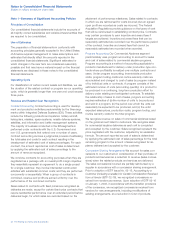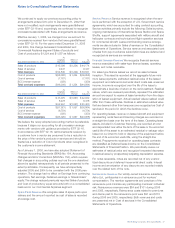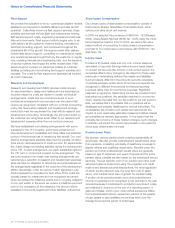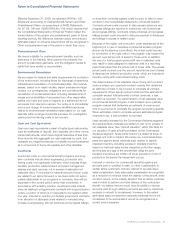Boeing 2006 Annual Report Download - page 41
Download and view the complete annual report
Please find page 41 of the 2006 Boeing annual report below. You can navigate through the pages in the report by either clicking on the pages listed below, or by using the keyword search tool below to find specific information within the annual report.
The Boeing Company and Subsidiaries 39
Management’s Discussion and Analysis
Goodwill Impairment
Goodwill and other acquired intangible assets with indefinite
lives are not amortized but are tested for impairment annually,
and when an event occurs or circumstances change such that
it is reasonably possible that an impairment may exist. Our
annual testing date is April 1. We test goodwill for impairment
by first comparing the book value of net assets to the fair value
of the related operations. If the fair value is determined to be
less than book value, a second step is performed to compute
the amount of the impairment. In this process, a fair value for
goodwill is estimated, based in part on the fair value of the
operations, and is compared to its carrying value. The shortfall
of the fair value below carrying value represents the amount of
goodwill impairment.
We estimate the fair values of the related operations using dis-
counted cash flows. Forecasts of future cash flows are based
on our best estimate of future sales and operating costs, based
primarily on existing firm orders, expected future orders, con-
tracts with suppliers, labor agreements, and general market
conditions. Changes in these forecasts could significantly
change the amount of impairment recorded, if any.
The cash flow forecasts are adjusted by an appropriate dis-
count rate derived from our market capitalization plus a suitable
control premium at the date of evaluation. Therefore, changes
in the stock price may also affect the amount of impairment
recorded. At the date of our previous impairment test, a 10%
increase or decrease in the value of our common stock would
have had no impact on the financial statements.
Postretirement Plans
We have defined benefit pension plans covering substantially all
our employees. We also have postretirement benefits consisting
principally of healthcare coverage for eligible retirees and quali-
fying dependents. Accounting rules require an annual measure-
ment of our projected obligations and plan assets. These
measurements require several assumptions, the most significant
of which are the discount rate, the expected long-term rate of
asset return, and the medical trend rate (rate of growth for
medical costs). Changes in assumptions can significantly affect
our future annual expense. In addition, as result of our adoption
of SFAS No. 158, changes in assumptions could significantly
increase or decrease Shareholders’ Equity (net of taxes) at
future measurement dates.
We use a discount rate that is based on a point-in-time esti-
mate as of our September 30 annual measurement date.
Changes in the discount rate will increase or decrease our
recorded liabilities with a corresponding adjustment to
Shareholders’ Equity as of the measurement date. In future
reporting periods, the adjustment for a change in the discount
rate will be recognized in Other comprehensive loss in the
period in which it occurs. In the following table, we show the
sensitivity of our pension and other postretirement benefit plan
liabilities and net periodic cost to a 25 basis point change in
the discount rate.
As of September 30, 2006 (Dollars in millions)
Change in discount rate
Increase 25 bps Decrease 25 bps
Pension Plans
Projected benefit obligation (pensions) (1,271) 1,555
Net periodic pension cost (145) 165
Other postretirement benefit plans
Accumulated postretirement
benefit obligation (181) 212
Net periodic postretirement benefit cost (14) 15
Pension expense is also sensitive to changes in the expected
long-term rate of asset return. An increase or decrease of
25 basis points in the expected long-term rate of asset return
would have increased or decreased 2006 pension income by
approximately $108 million. Differences between the actual
return on plan assets and the expected long-term rate of return
are reflected in Shareholders’ Equity (net of taxes) as of our
annual measurement date. In future reporting periods, the
difference between the actual return on plan assets and the
expected long-term rate of return will be recognized in Other
comprehensive loss in the period in which it occurs.
The assumed medical trend rates have a significant affect on the
following year’s expense recorded liabilities and Shareholders’
Equity. In the following table, we show the sensitivity of our
other postretirement benefit plan liabilities and net periodic cost
to a 100 basis point change.
As of September 30, 2006 (Dollars in millions)
Change in medical trend rate
Increase 100 bps Decrease 100 bps
Other postretirement benefit plans
Accumulated postretirement
benefit obligation 683 (652)
Net periodic postretirement benefit cost 127 (116)
Standards Issued and Not Yet Implemented
See Note 2 in the Notes to our consolidated financial state-
ments included herein.
Contingent Items
Various legal proceedings, claims and investigations are pend-
ing against us. Most significant legal proceedings are related
to matters covered by our insurance. Major contingencies are
discussed in Note 22, including our contesting the default ter-
mination of the A-12 aircraft, employment and benefits litigation
brought by several of our employees, and litigation/arbitration
involving BSSI.


